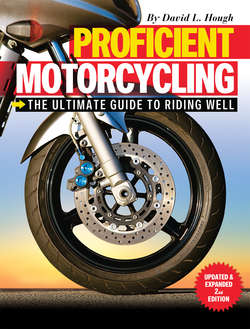Читать книгу Proficient Motorcycling - David L. Hough - Страница 11
На сайте Литреса книга снята с продажи.
Risk Acceptance
ОглавлениеYou’ll encounter lots of other motorcyclists charging ahead aggressively on public roads, seriously captured by a road-race mentality, always measuring their worth in terms of who passed and who got passed. Odds are 10 to 1 the road is clear today, with no sleepy drivers wandering across the centerline and no fresh boulders lying on the road halfway around a blind turn. Of course, on every sunny Sunday on twisty roads across America, a few of those daring riders with a higher risk acceptance lose the gamble. Blind corners are one reason some riders almost always arrive at the biker hangout first. Personally, I’m not willing to gamble my life that the blind curve ahead isn’t blocked by a fallen tree, logging truck, or wandering horse. But, I’ve also ridden with those who don’t share my conservative attitude about gambling my life, and I’ve let them speed ahead.
The point is, each of us has a different level of awareness about potentially hazardous situations and a different risk acceptance. There are a growing number of motorcyclists who measure their self-worth in terms of their own skill and their personal enjoyment of the ride, not someone else’s. As you grow older, it gets easier to accept that riding on public roads must have a very different focus from riding on a racetrack. I’m out to have a good time, which includes not only arriving home with body and motorcycle parts unscathed but also enjoying the scenery and taking some satisfaction from having the motorcycle well under control.
If you believe the covers of today’s motorcycling magazines, the purpose of motorcycling is to ride as fast as you can and lean over in the curves until your chicken strips and knee sliders get respectably scuffed. Road racers are held up as our heroes, and race-replica sportbikes are what you really should want. Of course, today’s sports machines really are good. If you could roll a box-stock Honda CBR100RR, a Kawasaki ZX-14, or a Yamaha YZF R1 off the showroom floor and into a time machine and transport it back just ten years, you’d have a faster, better handling motorcycle than the big-buck factory race bikes of the day.
And that’s really a dilemma for today’s motorcyclists. There’s this image of me on a high-zoot sportbike, passing every other motorcyclist on the road, half Mike Hailwood and half Joey Dunlop. OK, if I were younger, it might be Valentino Rossi and Kenny Roberts Jr. But I don’t ride the track. The dreamy perfect racer image gets pushed aside by the nightmare of a gravel truck making a left turn out of a hidden driveway, a horse that has escaped from a pasture, a splash of spilled diesel oil, or a rusty pickup truck weaving across the line as the driver flings an empty Jack Daniels bottle into my path.
Sure, I’d like to think of myself as a good rider, but I’d like to stick around for a while longer. I can’t escape the knowledge that public roads are full of hazards that could quickly and permanently end my motorcycling. There are lots of riders who are willing to push the envelope on public roads, but they seem to have very short riding careers. For me, jacking up the risks of a ticket or a crash is unacceptable. I’ve also discovered over the years that what’s important is to enjoy the ride, and only a modest part of that enjoyment relates to speed. There’s tremendous enjoyment in riding a motorcycle at the right speed for the situation, rather than at the maximum speed; getting the motorcycle “in the groove,” and knowing you have more performance in the bank should you need it or choose to use it.
